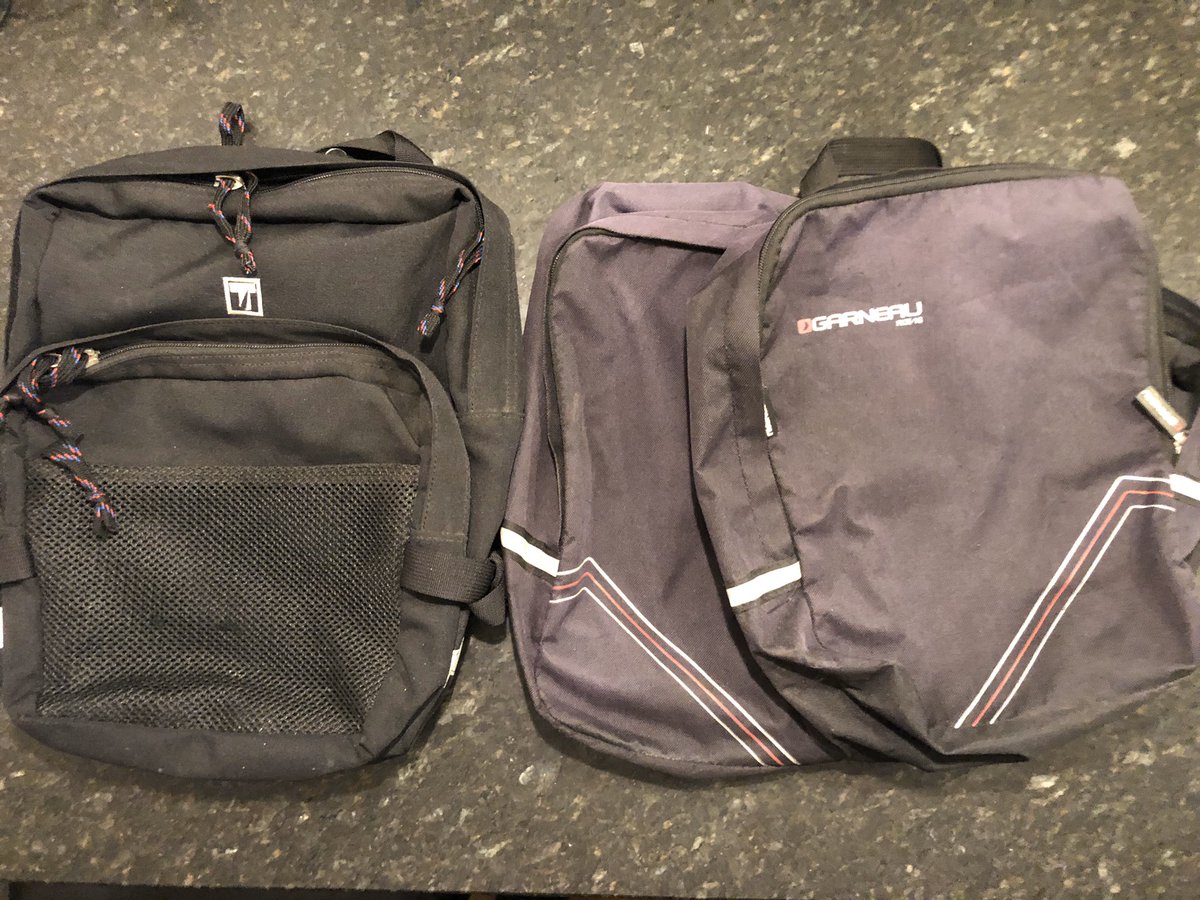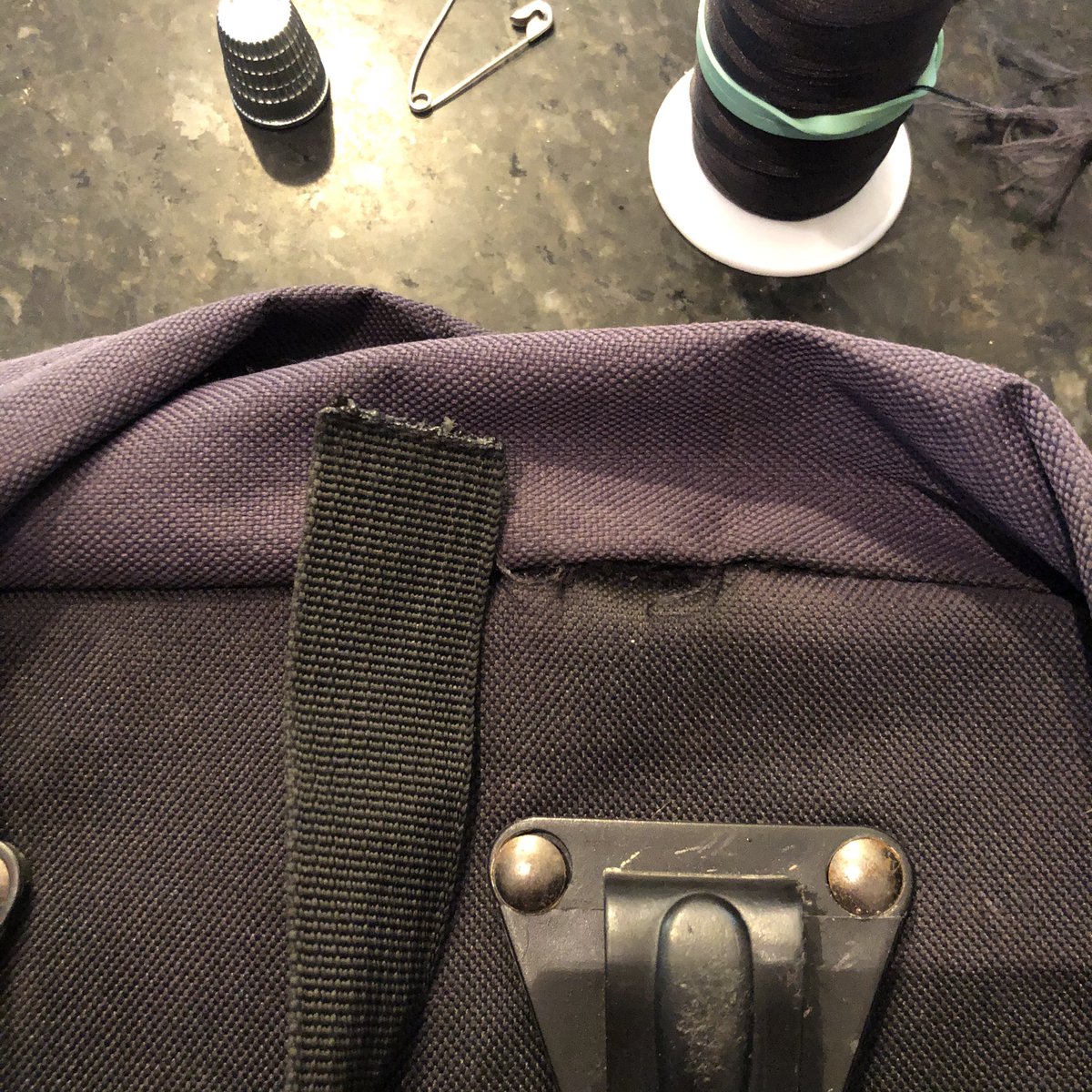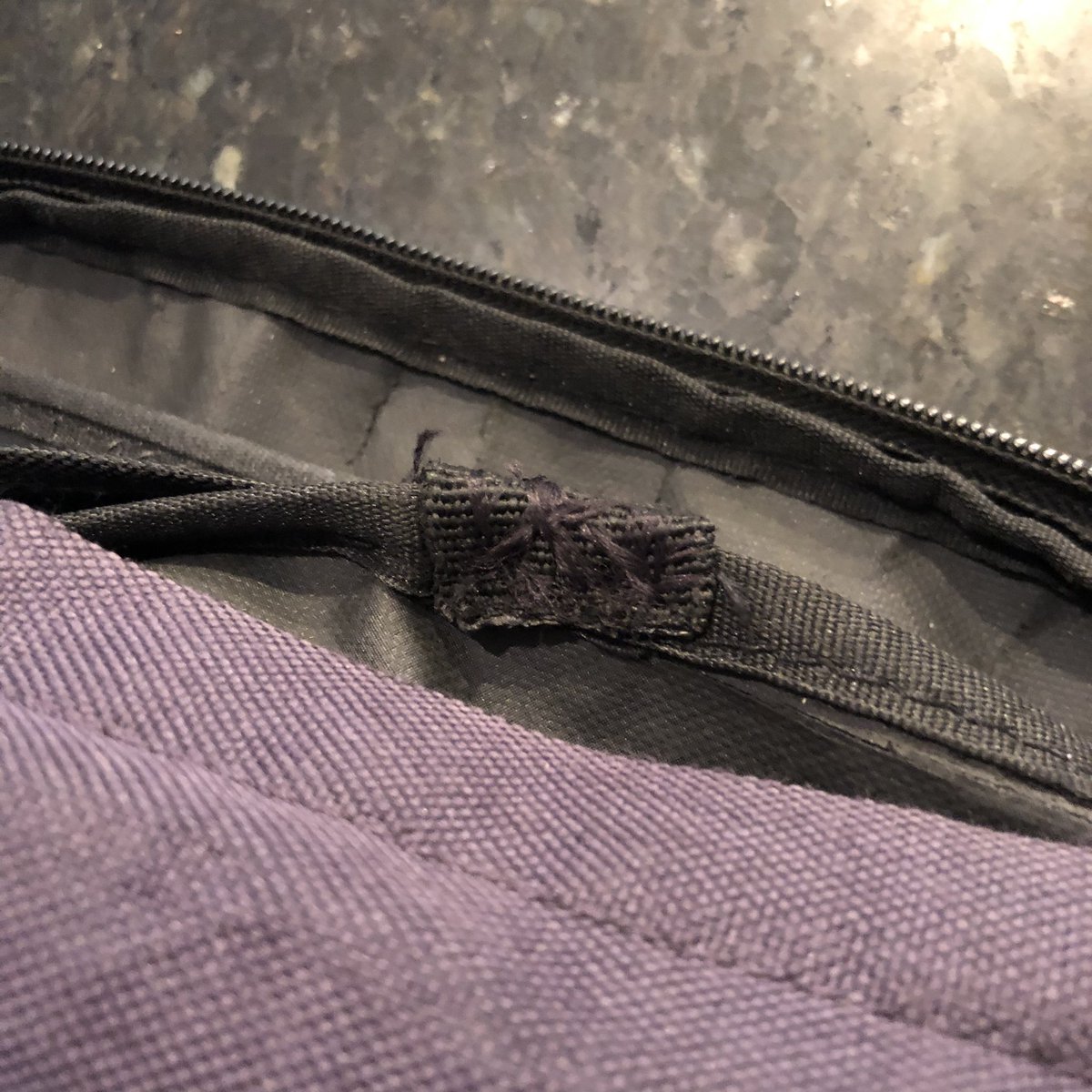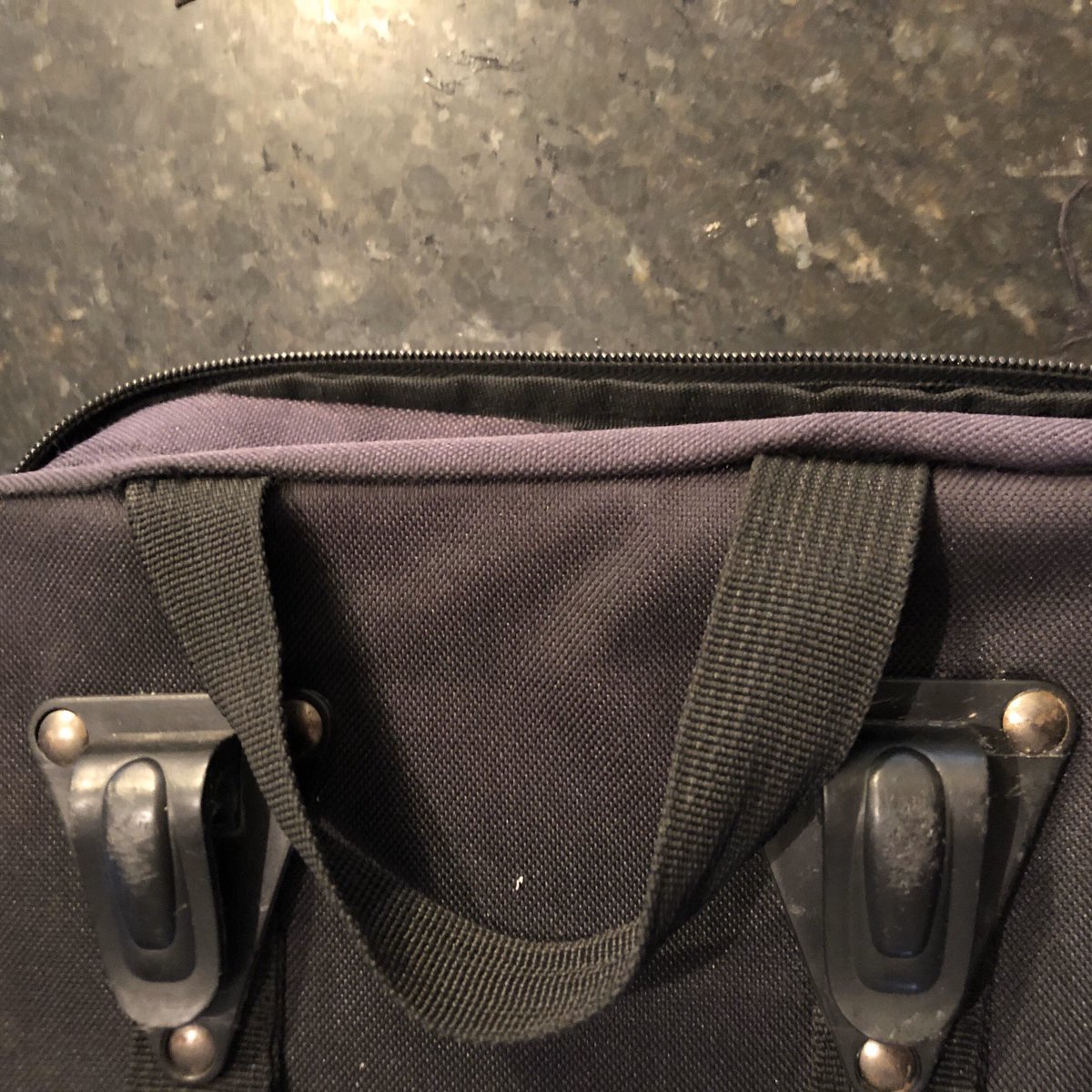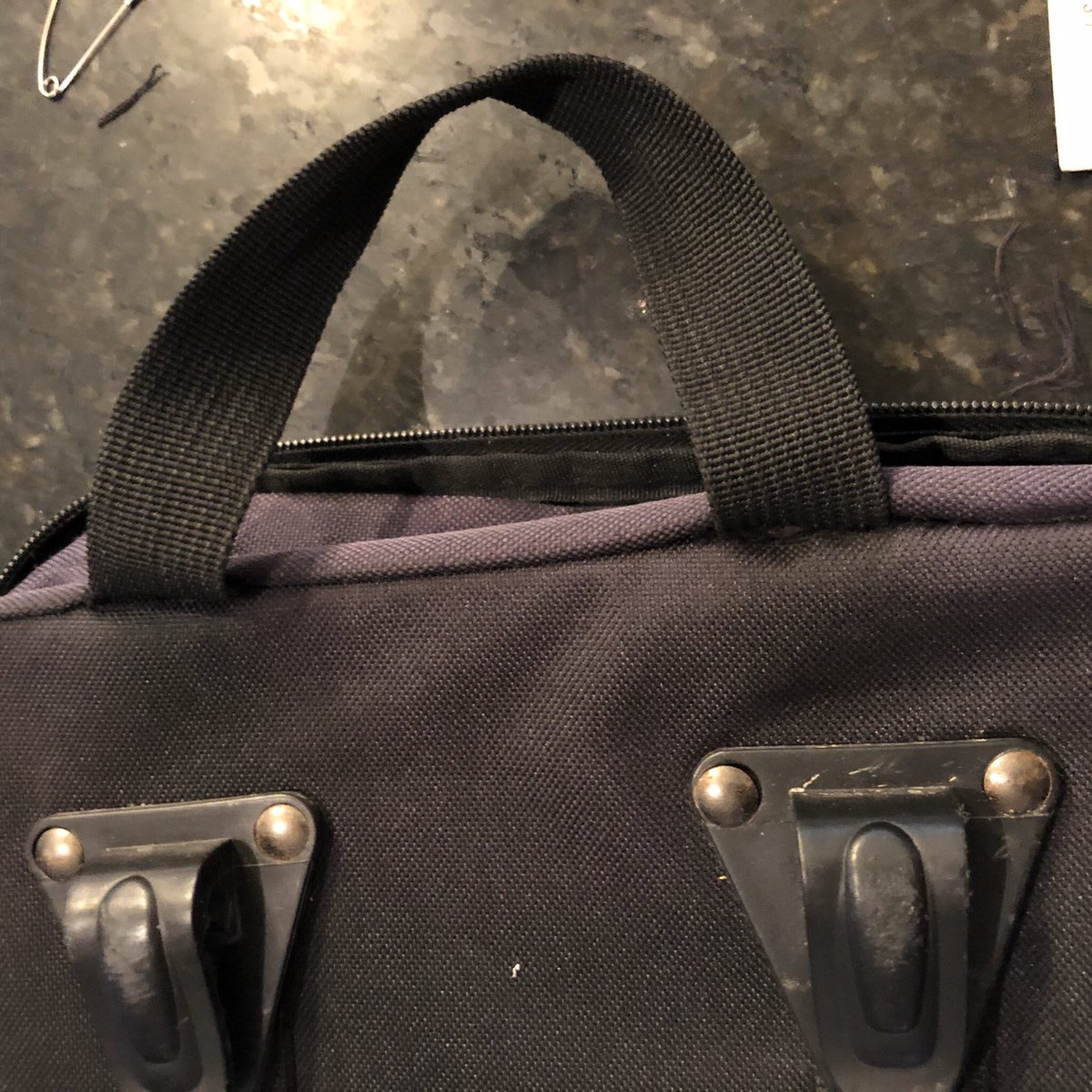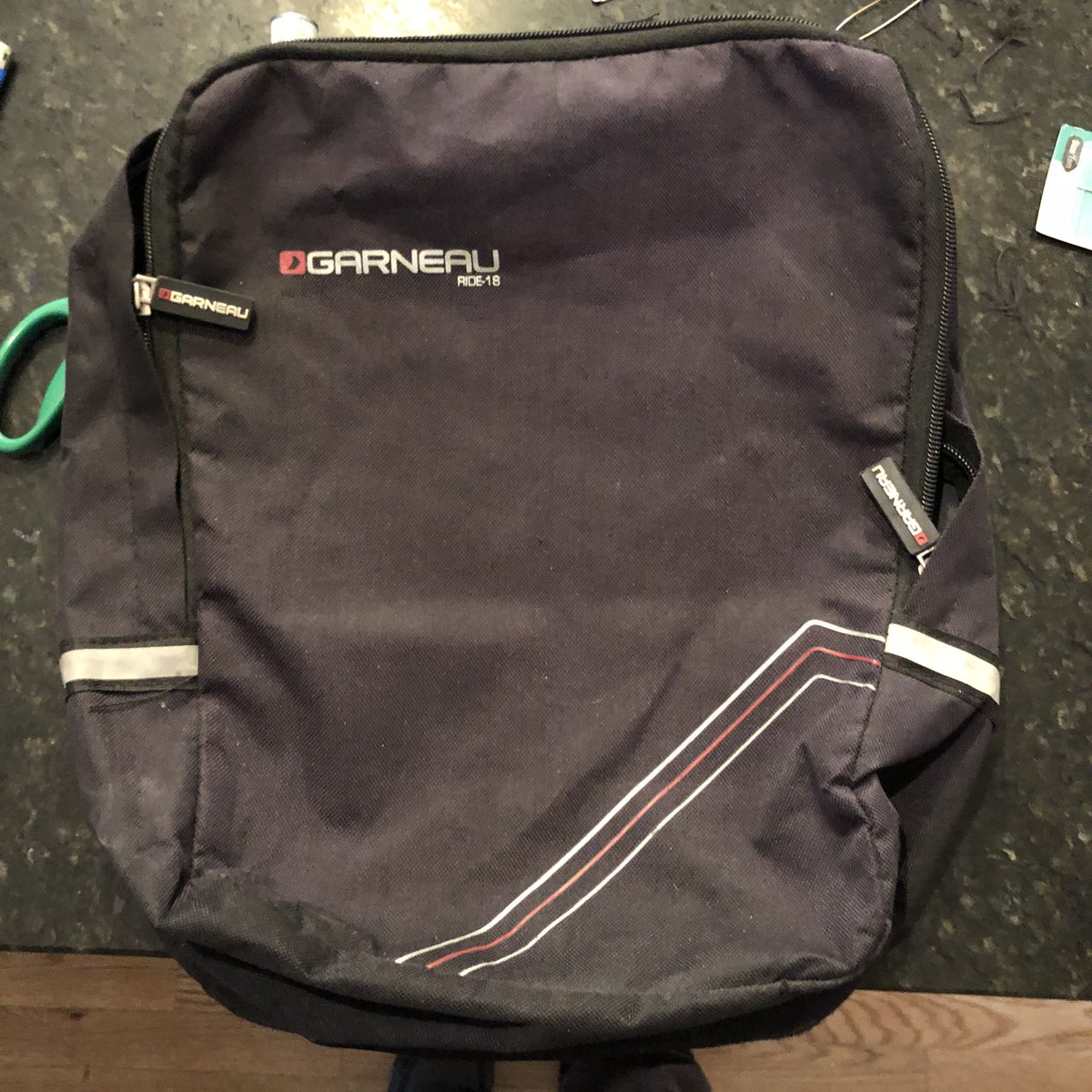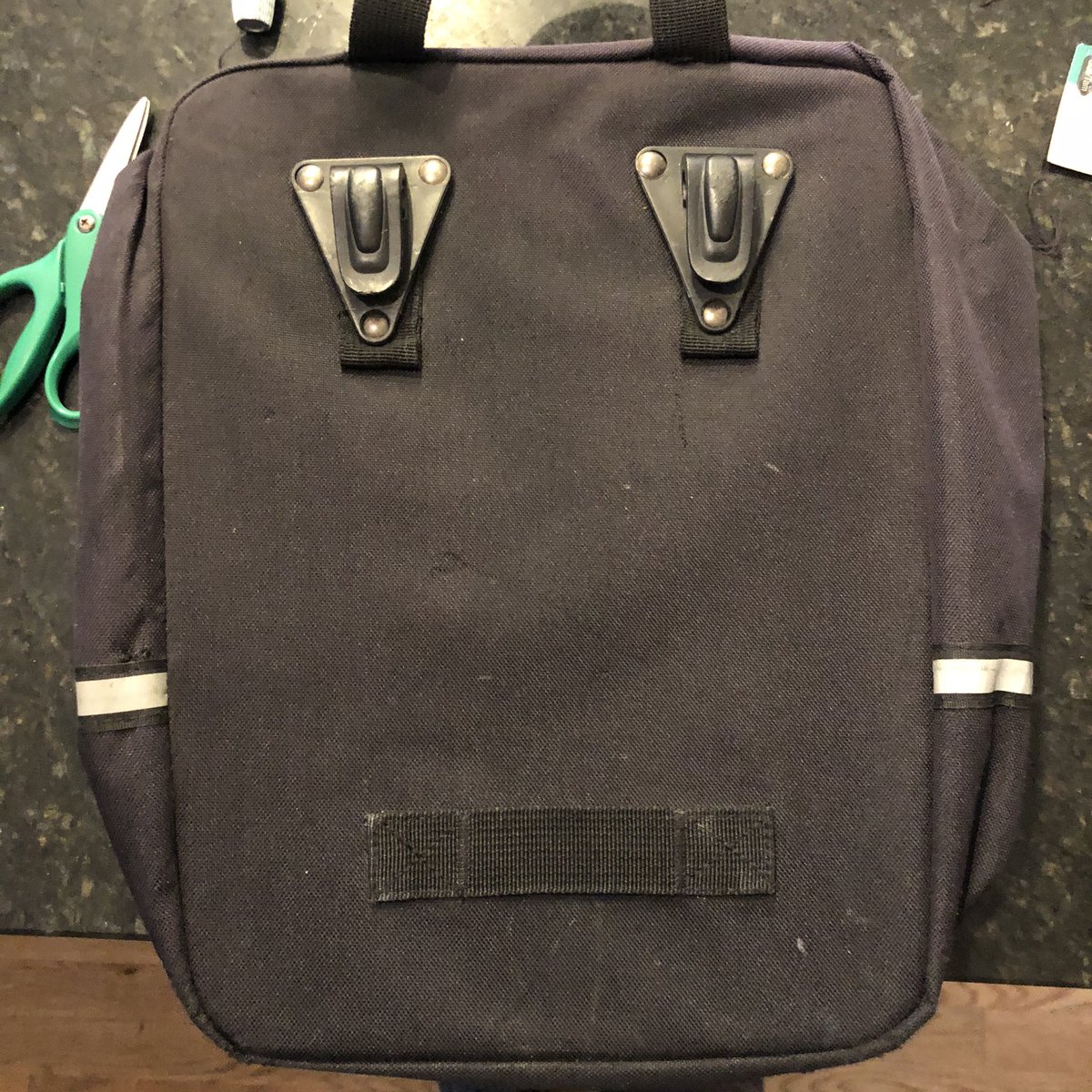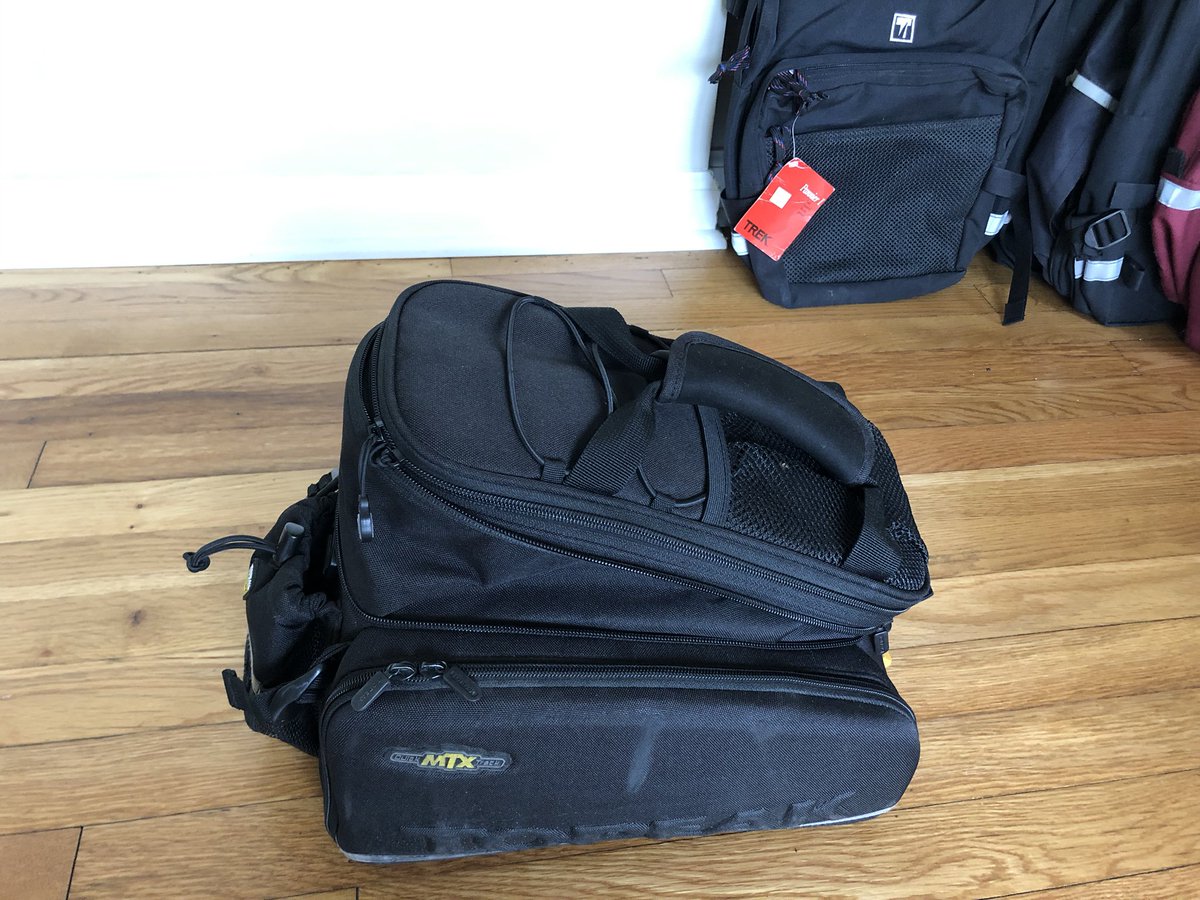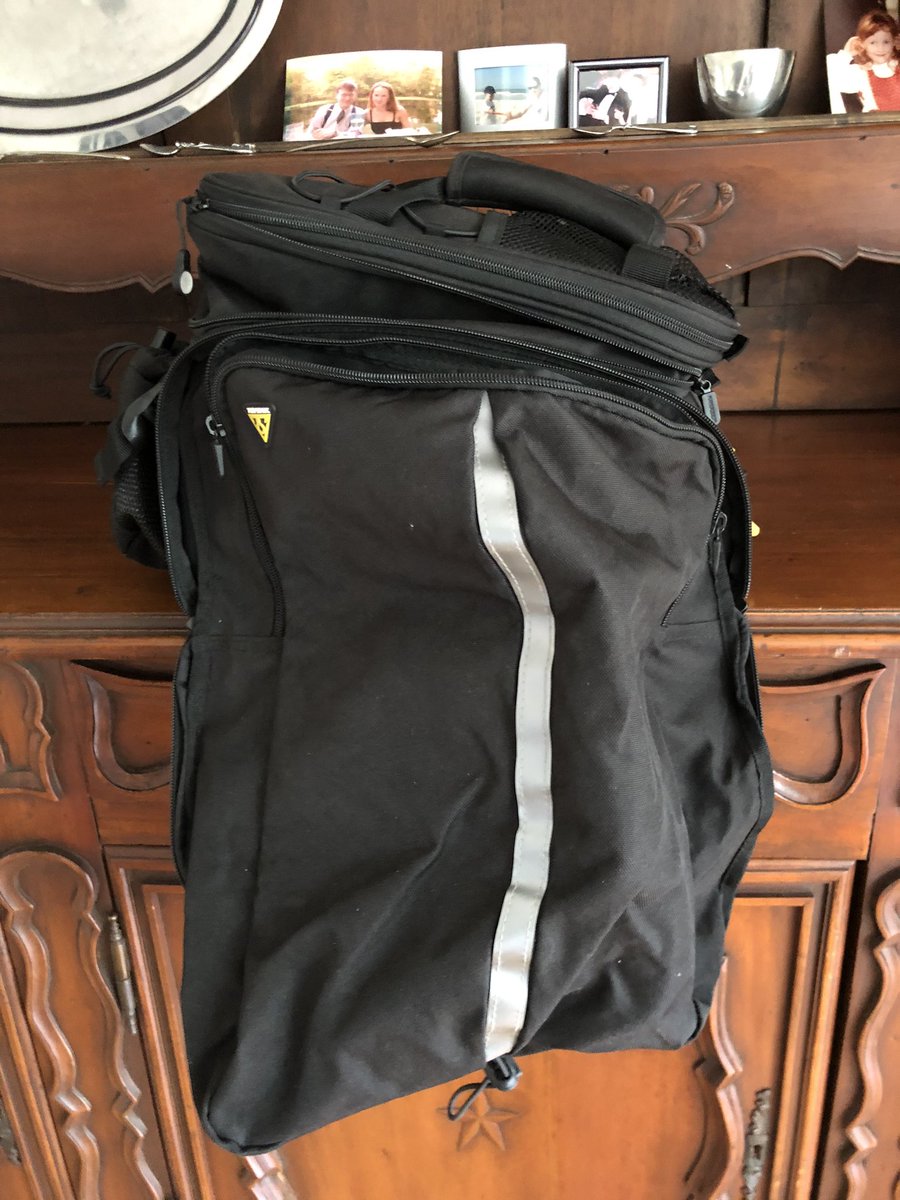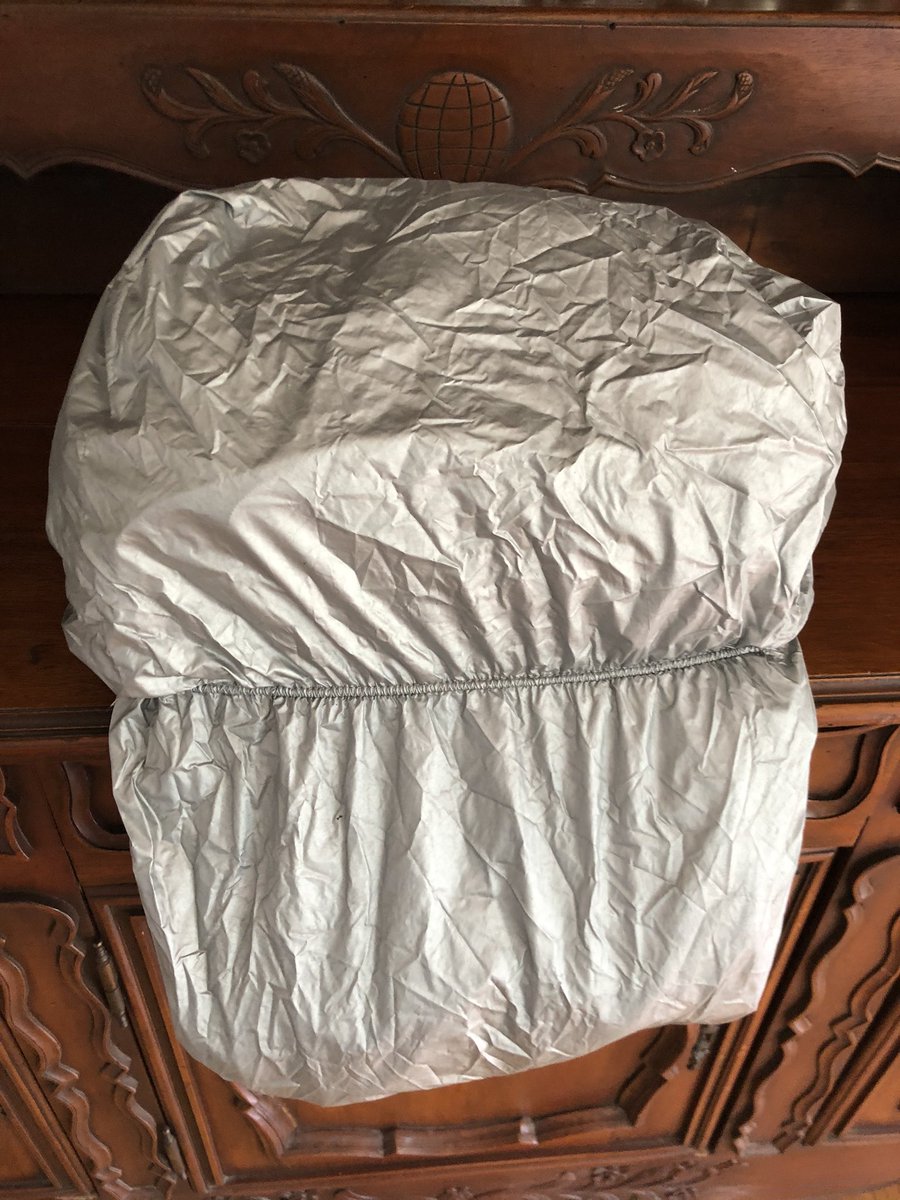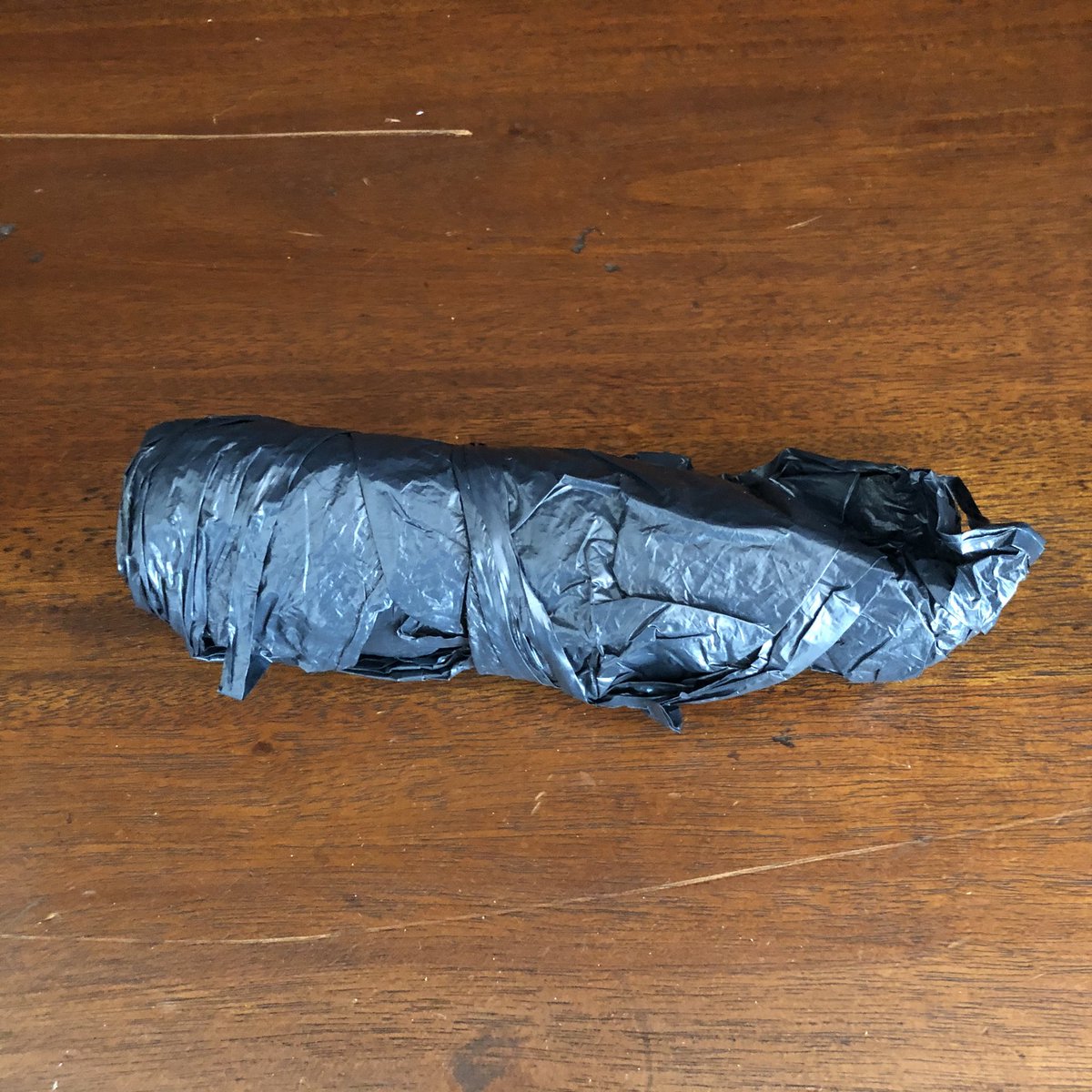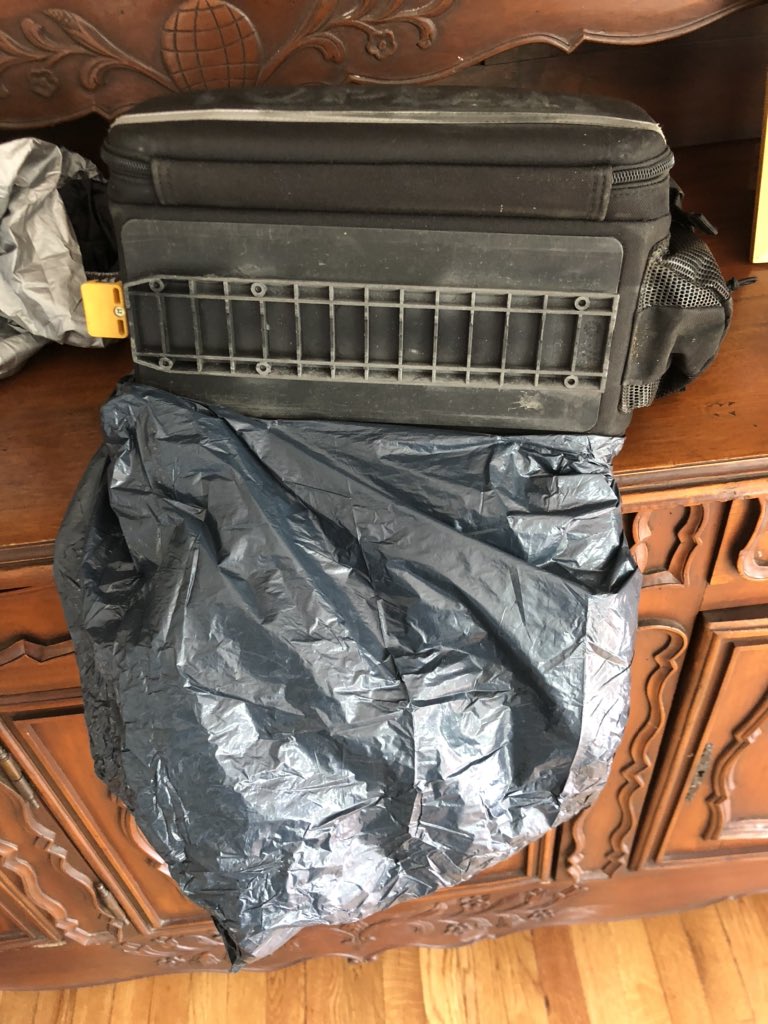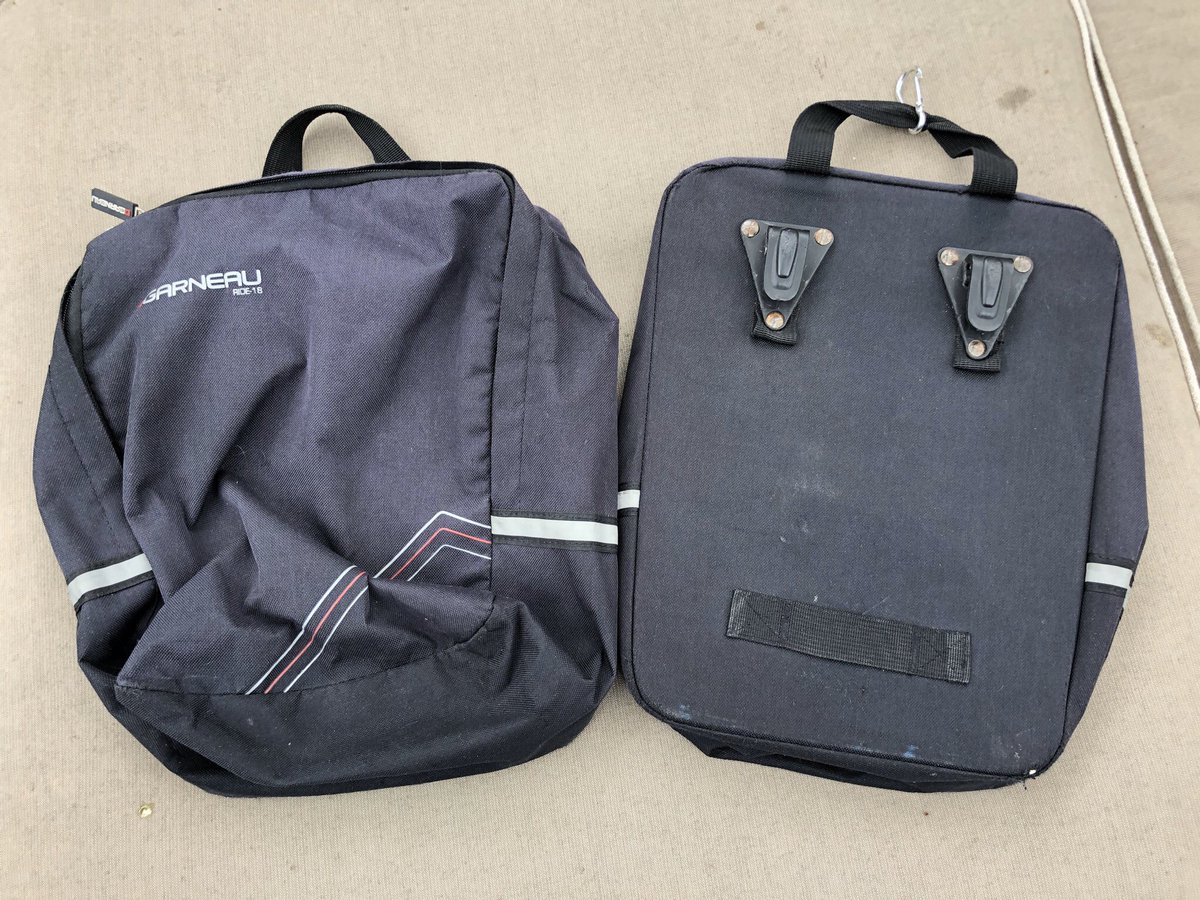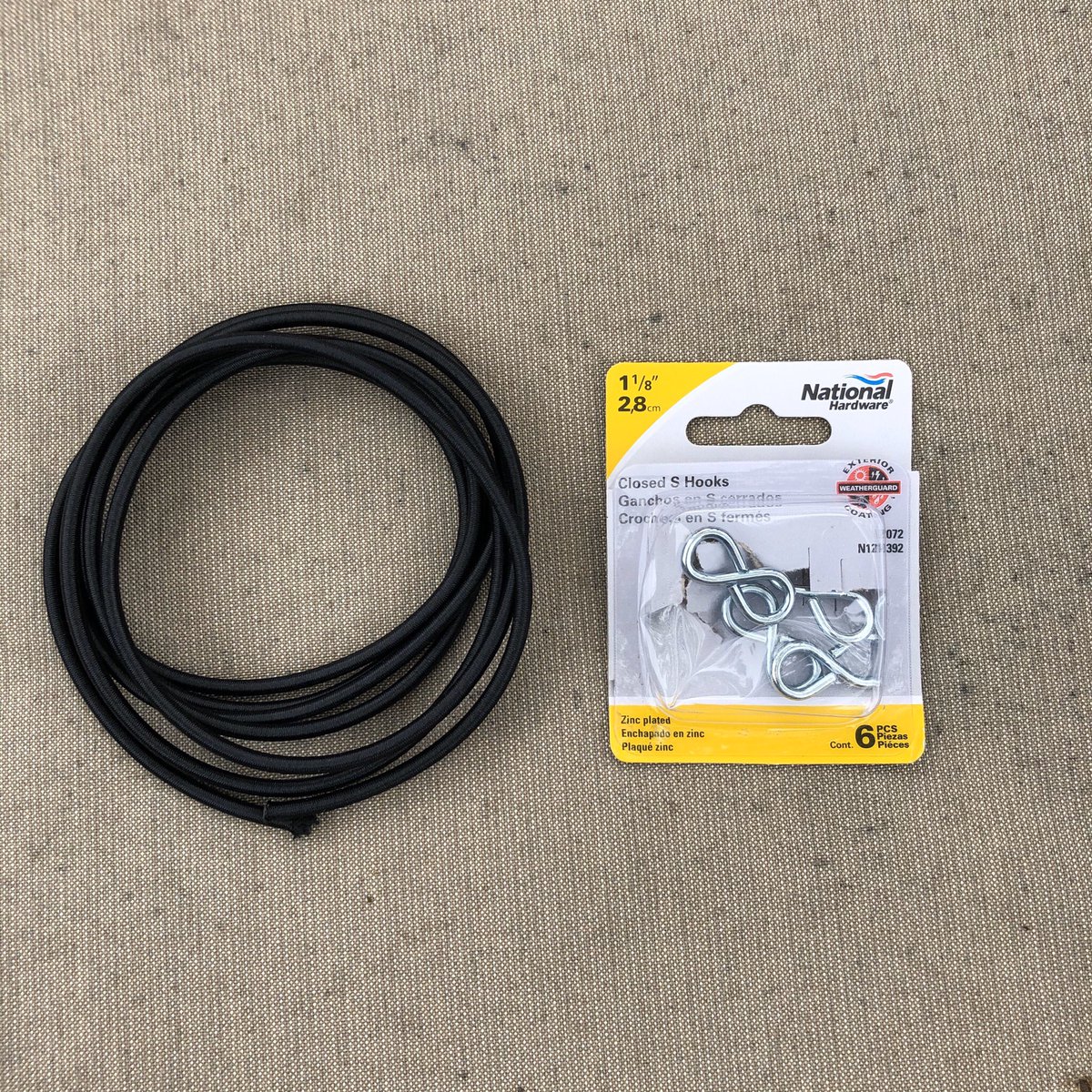I commute by bike, ride tours, shop by bike, and carry stuff with me on bike rides, so I have a lot of it, most for different purposes.
The three bags in the top photo are just the stuff I had out from the panniers footlocker, those bags, a mid-90’s Trek Pannier 1 and two late-00’s Louis Garneau Ride-18 units, are scheduled for some work.
Being in the pandemic and all, I am starting to get down to some of the backburner projects.
I picked up the Garneau bags on Nashbar closeout in 2012, they are as simple as you can get: One-compartment square bag with a zipper.
They went with me on my first-ever bike tour in 2012, a 4-day, 380-mile hotel tour from Alexandria, Va. to Pittsburgh, Pa.
They went with me on my first-ever bike tour in 2012, a 4-day, 380-mile hotel tour from Alexandria, Va. to Pittsburgh, Pa.
For a few years after that, they did front-bag duty on my commuter, one-compartment boxy panniers are really good for shopping on the way home from work.
The elastic shock cord on the back of both wore out and they then became neighborhood bags; good for carrying your kid’s hoodie when he inevitably gets hot on a family ride.
The last indignity was when the strap on one of the bags pulled out from the seam when I jerked too hard getting it off the bike. We are going to fix that problem tonight.
As you can see from this photo and the top photo, these bags are really sun-faded.
My sewing skills are self-taught from attaching patches to jean jackets. I pulled the handle through and folded it over so each stitch would pass through the handle twice and the bag seam once.
Underside view of fix. It is not factory-certified, this is an 8-year old bag that has seen heavy use. I just need it for neighborhood and light (i.e., S24O) touring.
Front view of the bag. There should always be a $40 set of super-basic front panniers on the market for beginners.
Back of the bag. I have an order in for 16 feet of 6mm (1/4-in) elastic shock cord and a variety of cord-end fixers. The lower elastic-band rack hook will be restored through the fabric loops below the upper rack hooks (the upper hooks are riveted and do not screw off).
This might also be a @FacesPics.
Here is my principal commuting bag, a Topeak MTX Trunkbag DXP. This is my third one, with the first lasting six years and the second only two.
Here are my previous/other Topeak commuting bags, two MTX Trunkbag DXP’s and an old MTX Trunkbag of unknown model.
The leftern-most bag is the original Topeak commuting back from 2011. It served me admirably for about six years before one of the top compartment zippers lost its hold, now it only zips from one side.
So it is still serviceable, and comes out when needed for neighborhood rides or if a fellow rider needs a bag. I had no idea how sun-faded it was or how limp the once-stiff body had become until I acquired the second bag.
The second bag (in the middle) lasted only two years, as one of the deployable panniers (more on this in a moment) began separating from the main bag body. While I was able to do an amateur sew-job on it, the longevity was permanently impacted.
The third bad (on the right) is a very old MTX Trunkbag of unknown provenance. It was a ground score one day about four years ago while riding the & #39;road route& #39; home (through the Pentagon and Crystal City, rather than down the Mt. Vernon Trail).
I posted to lost and found on every local bike message board to no avail. All it had in it was a pair of size 13 crocs and a pair of inexpensive riding shades.
It is even more sun-faded and battered than my oldest bag. While it has the Topeak rail system (more on this in a moment), it also has velcro straps for attachment to a non-Topeak rack. This is likely how it fell off the previous owner& #39;s bike.
I use this bag mostly for the period *after* I have built my latest touring bike and *before* my next tour, which is when I break the bike in and road test it as a temporary commuter. The touring bikes have the old Jim Backburn racks (no Topeak rack will touch a 620 or 720).
The Topeak bags are nice for three main reasons:
* Top-trunk style
* Folding panniers for variable capacity
* Proprietary Topeak rack system
* Top-trunk style
* Folding panniers for variable capacity
* Proprietary Topeak rack system
I prefer the trunk bags (that fit on top of a rack, as opposed to a pannier bag that hangs) for carrying food. I carry in my breakfast and lunch to work every day and keeping it upright (and not flipped, sideways, or squashed by other stuff) ensures I can carry a wider range.
Also, it keeps clothing and food structurally separated.
The sides of the bag have deployable, fold-down panniers. These allow me to vary my carrying capacity.
In the warm months, I can carry two clothing setups in each fold-down pannier, where a setup is a hand towel, washcloth, underwear, t-shirt and socks in a rubber banded rollup, and a Navy-rolled dress shirt.
In the cold months, I store my entire winter wardrobe in one fold-down pannier, and use the other for reduced-capacity clothing carry. (Front bags increase my carry capacity but are notwithstanding this discussion.)
I live in the Washington, DC area, which gets more rain than Seattle, Wa., but has fewer rainy days (both are true, don& #39;t make me Google that shit for you), so I need a solid, but not necessarily omnipresent weather solution.
If I lived and commuted in a rainier environment, I might just use Ortliebs or some other waterproof solution, but by volume, most of my commutes are dry.
I have the rain cover for the bag, as you can see from the design, elastic bands delineate coverage sections, and it has a reflector on the rear. You tuck the pannier covers up into the trunk section if not deployed.
Here is the cover over the bag with one pannier down. There is nothing in the pannier, so this is just a dry test.
The rain cover lasts about as long as the bag, so they get replaced on the same cycle. The cover has a bit of a limitation, go back and look at the picture of the empty cover.
When the cover is stretched over a deployed pannier, it covers the *outside* of the pannier, but not the inside, which is still exposed to the wheel.
So if you are not riding with fenders/mudguards (which I am not, ever), then water splashes all over the inside surface of the deployed pannier. To make matters worse, the elastic band delineating the pannier section tends to create a low spot where water pools.
I suppose I could address this matter by riding fenders (and by extension, it seems as though this solution was *designed* for riders using fenders), but fenders are literally the devil and I will never, ever use them. They don& #39;t exist for me in the metaphysical sense.
So I had to come up with a solution, I managed to dredge up a message board posting years ago that prescribed the solution I still use.
That solution involves two grocery bags, one for each side. These are the slightly heavier, black bags used at Virginia ABC stores for liquor purchases. They are rolled up as they live normally inside the rolled-up rain cover.
The top of the bag has an elastic cord with an adjustable cord stop. It would hold down a newspaper or pair of flip-flops stuffed into the top mesh pocket.
‘Sack up’ the deployed pannier in the grocery bag, thread the elastic cord through the eyelets on the trunk bag and through the grocery bag handles, and you have a reasonable water-resistance solution for the deployed pannier.
Here is a look at the insde surface of the deployed pannier, sacked up (note also the sliding rail and lock mechanism, we will come back to this).
With the sack covering the bottom and the rain cover over the outside, it is not hurricane-proof, but does a good job in all but the heaviest rains.
Let’s get back to that rail system. The racks have a rail, the bags connect and slide on, and are locked in place with a spring-loaded switch. It is very utilitarian.
The whole bag, in any deployment config, goes with me (one-handed), and slides on and off the rack easily. It’s a convenience made for commuting.
In practice, it means the MTX bags (the ‘X’ apparently designates the bag as slide-rail attachment) cannot be used with non-Topeak racks. Topeak racks, on the other hand, can be used with most modern panniers.
There is a certain switching cost associated with these product choices; the racks are immortal. From a product synergy perspective, the convenience of the system outweighs the limitations, and the racks last forever.
As long as my commuting situation remains the same, I will keep using these products.
Let’s rehab some panniers. These are the Garneau Ride-18 front bags I worked on upthread, repairing the fabric handle of one.
The original elastic shock cord and lower hook are long gone, I have acquired replacements.
1/4-inch shock cord turned out to be too fat, and the fabric loops under the upper rack hooks are too tight for closed-end cord hook ends, so I picked up some 1/8-in cord and S-hooks from the hardware store.
The hooks package is already missing two from an older job, to replace irritating O-rings on a set of Rhode Gear front panniers with hooks for use with my Tubus and Jim Blackburn racks (those bags are attached to a bike and will appear in this thread at a later date).

 Read on Twitter
Read on Twitter